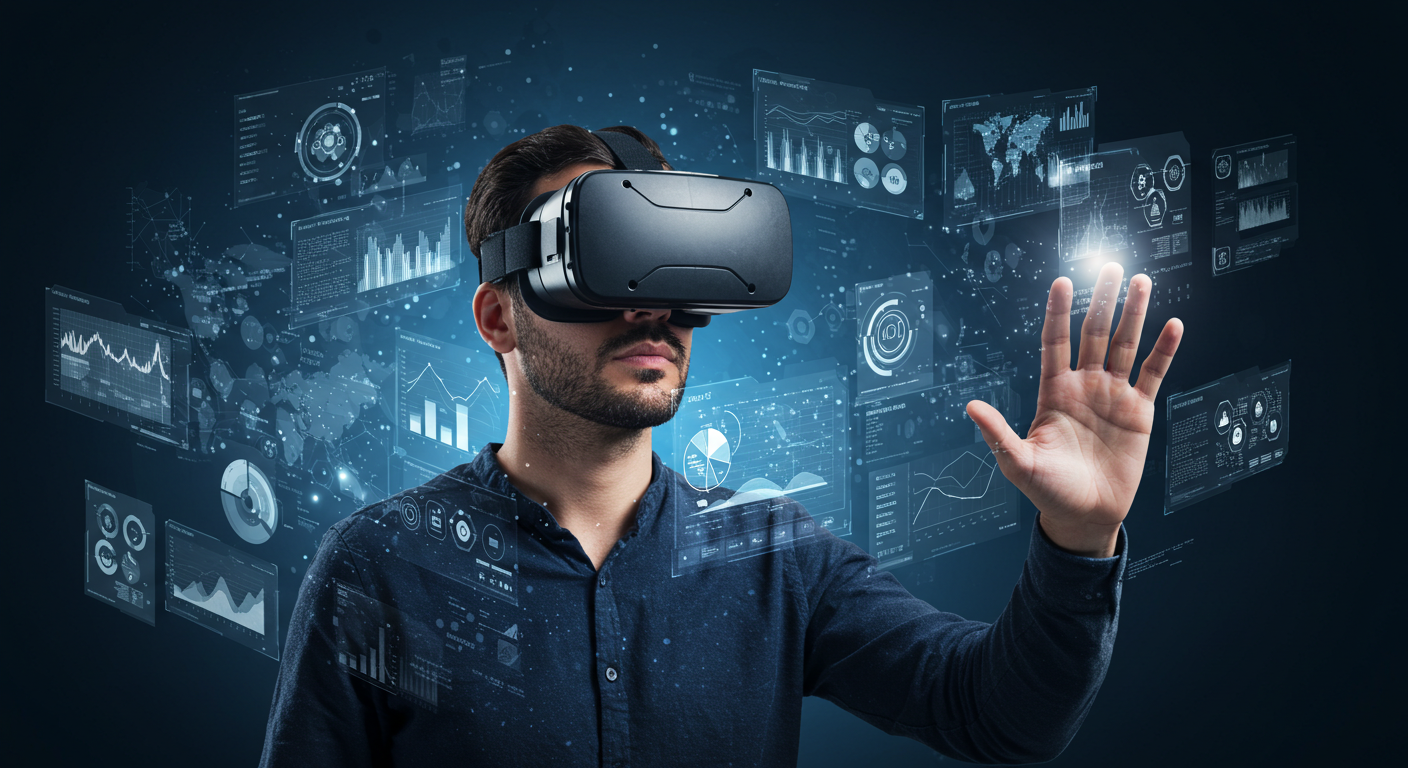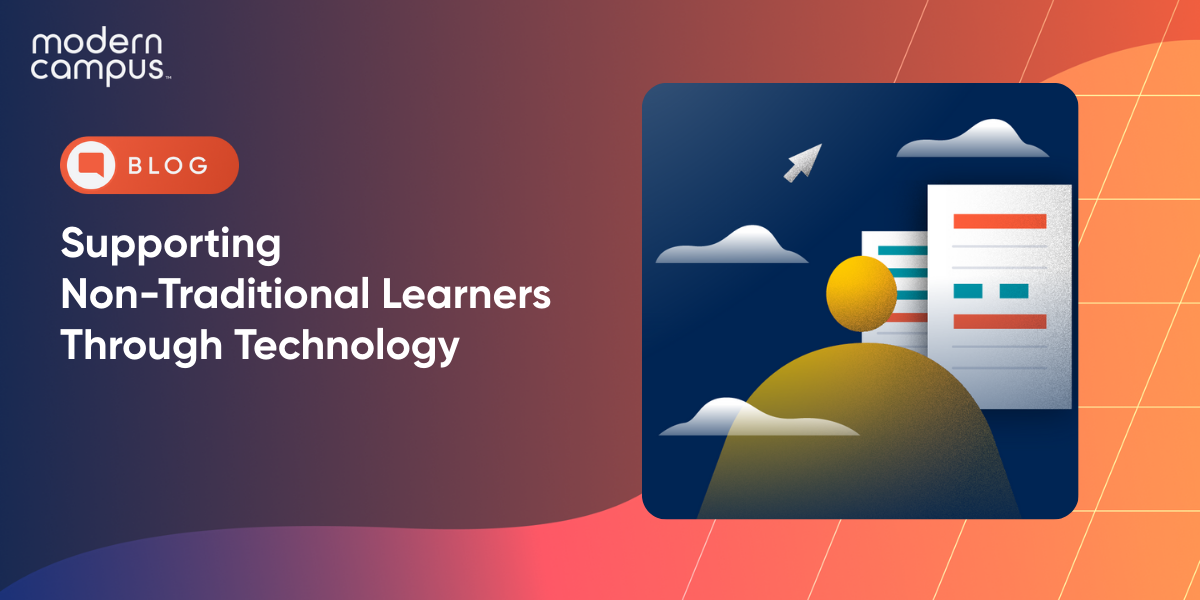Supporting Non-Traditional Learners Through Technology
Technology has become essential for supporting non-traditional learners, but significant barriers remain.
- Growing demand: Fall 2024 data shows growth in non-traditional undergraduate students, while traditional enrollment declined
- Digital challenges: Varying tech literacy levels and resistance to change create significant adoption barriers for adult learners across all demographics
- AI transformation: 86% of students now use AI platforms for educational purposes
- Support solutions: Institutions implementing mobile-first approaches and personalized learning pathways see up to 35% improvement in student performance
Institutions that prioritize technology designed specifically for adult learners while addressing digital literacy gaps will dominate the future of lifelong learning.
Navigating higher education can pose challenges for non-traditional learners, who must navigate systems that inadequately address their distinctive needs. Learners enrolled in continued education programs, single classes and workplace development courses often encounter barriers when navigating existing technological systems, especially ones that are designed with degree-seeking undergraduate students in mind.
Non-traditional undergraduate students experienced 16.7–19.7% growth in Fall 2024, with the largest gains among students ages 25–29, while traditional freshman enrollment declined 5%. This decrease is the first drop in traditional enrollment since 2020, signaling a shift in higher education demographics.
The pressing need for technology platforms tailored explicitly for non-traditional learners has never been clearer. Below, we'll explore the best ways to eliminate barriers and pave clearer paths for all learners to succeed within your non-traditional programs and courses.
What Are the Key Benefits of Technology for Non-Traditional Learners?
By enhancing accessibility and flexibility, technology has opened up higher education to more students, expanding the potential number of adult learners who can enroll every year. Non-traditional learners, who often juggle work, family and other responsibilities, can now access educational resources anytime, anywhere, breaking free from the confines of a traditional classroom setting.
Flexibility and Accessibility Drive Participation
Technology eliminates traditional barriers that prevent adult learners from pursuing education. Online platforms and digital resources operate 24/7, allowing students to engage with coursework during early morning hours, lunch breaks or late evenings when family responsibilities permit. Scheduling flexibility proves essential for learners managing multiple commitments simultaneously.
Students using technology-enhanced learning approaches demonstrate up to 35% improvement in overall performance compared to traditional methods. The ability to pause, rewind and review content multiple times accommodates different learning paces and styles, creating more inclusive educational environments that serve diverse adult populations.
Real-World Application Bridges Theory and Practice
Technology enables the real-world application of knowledge, bringing theoretical concepts to life in practical scenarios. This bridging of theory and practice equips non-traditional students with immediately applicable skills and insights, enhancing the overall value of their education and preparing them for success in their professional endeavors. In essence, technology serves as a powerful ally, providing accessibility, flexibility, personalization and real-world relevance.
What Challenges Do Adult Learners Face with Educational Technology?
Implementing technology in adult education, particularly for non-traditional students, poses a set of distinctive challenges that institutions must address. Understanding these barriers is the first step to developing effective solutions that support learner success.
Digital Literacy Gaps Create Significant Barriers
One notable hurdle is the varying levels of tech literacy among this diverse group. Non-traditional students come from all walks of life, spanning various ages and backgrounds, and they might not all be equally familiar with high-tech tools. Research from Pew indicates that only 17% of adults are considered "Digitally Ready" for online learning, while 33% are classified as "Reluctant" users with low awareness of educational technology concepts.
The digital divide becomes particularly pronounced among older adult learners. While generative AI use has doubled from 9% to 18% among adults over 50, one-third cite data privacy concerns as the biggest barrier to technology adoption, followed by ease of use (20%) and setup support (19%).

Infrastructure and Access Limitations
Beyond individual skill levels, institutional barriers impact technology adoption success. The need for substantial initial investment in technology infrastructure can be a barrier, especially for institutions with limited resources. Despite historic funding increases, challenges persist as 24 million Americans still lack access to fixed broadband connectivity, disproportionately affecting rural, Tribal and low-income communities where many adult learners reside.
These connectivity gaps create cascading effects that impact entire community learning initiatives and workforce development programs.
Resistance to Change and Learning Curve Obstacles
Many adult learners have established learning preferences developed through previous educational experiences or professional training. The shift to technology-driven education requires not only acquiring new technical skills but also adapting familiar study habits and learning processes. Balancing the integration of technology with the preservation of effective learning environments is vital, as poorly implemented digital tools may inadvertently create additional barriers rather than solutions.
How Can Institutions Choose the Right Technology for Non-Traditional Students?
Selecting appropriate technology solutions requires understanding the unique characteristics and needs of adult learners. Institutions must evaluate options based on accessibility, ease of use and alignment with learning objectives specific to continuing education programs.
Prioritizing Mobile-First and Responsive Design
The mobile revolution has fundamentally changed how adult learners engage with educational content. In 2024, 65% of female students and 31% of male students enrolled in online classes, with many accessing content primarily through mobile devices. Institutions implementing mobile-responsive designs and adult education software that provides seamless mobile experiences see higher engagement rates among non-traditional learners.
Mobile-first approaches recognize that adult learners often access educational content during commutes, breaks at work or while managing family responsibilities. This flexibility is essential for maintaining consistent learning momentum despite busy schedules.
Integration Capabilities and Scalability
Technology solutions must integrate with existing institutional infrastructure while providing room for growth. The most effective platforms offer API connectivity, data sharing capabilities and compatibility with multiple devices and operating systems. This integration ensures that students and staff can work efficiently without navigating multiple disconnected systems.
What Types of Technology Best Support Adult Learners?
Technology is a pivotal force in dismantling barriers and fostering inclusivity for all learners. While technology often originates with the masses in mind, the current dynamic calls for a more nuanced approach, one that recognizes and resolves the specific hurdles faced by non-traditional students.
Essential Technology Solutions for Adult Education
Learning Management Systems (LMS) Designed for Continuing Education: The LMS market is expected to reach $70.83 billion by 2030, driven by non-traditional learner needs. Modern LMS platforms specifically designed for adult learners offer features like flexible scheduling, competency-based progression and integration with workforce development tracking.
Current AI Implementation in Education: Artificial intelligence has moved from experimental to essential in education. Student adoption of AI tools reached 86%, with learners using these platforms for research assistance, writing support and study planning. Current AI applications focus on content delivery optimization and basic adaptive learning features.
Responsive Learning Applications: With 87% of households having smartphones, computers or tablets, mobile learning apps provide essential accessibility for learners who study during brief time windows. These applications must offer offline capability, quick sync features and intuitive navigation designed for small-screen interactions.
Communication and Collaboration Platforms: Research shows that 80% of employees agree that gamified learning is more engaging, while communication tools that enable peer-to-peer learning and instructor interaction help maintain social connections.
Emerging Technologies Reshaping Adult Education
Micro-Learning and Bite-Sized Content: Adult learners prefer modules that fit into their busy schedules. Micro-learning platforms that deliver content in 5–10 minute segments allow for consistent progress without overwhelming time commitments.
Blockchain for Credentials and Certificates: As 51% of global leaders incorporate micro-credentials within their institutions, blockchain technology provides secure, verifiable credentialing that employers trust and learners can easily share across platforms.
How Do Support Systems Enhance Technology Adoption?
Even the most sophisticated technology solutions fail without proper support. Adult learners require comprehensive assistance that addresses both technical challenges and learning strategies specific to their unique circumstances.

Comprehensive Support Infrastructure and Training
Institutions must provide robust technical support that accommodates diverse technology backgrounds and learning schedules. Consider multiple support channels (phone, email, chat, in-person), extended hours that align with working adult schedules and proactive troubleshooting resources that anticipate common issues before they become barriers to completion.
Institutions should integrate foundational digital skills into program orientation and ongoing curriculum. With concerns over data privacy being the biggest barrier to tech adoption, training programs must also address security concerns and establish confidence in online learning environments.
Peer Networks and Community Building
Creating networks and support groups for non-traditional learners establishes peer connections that enhance both technical adoption and academic success. These communities provide platforms for sharing experiences, collaboratively troubleshooting challenges and maintaining motivation throughout educational journeys.
Faculty Development and Training
Educators working with adult learners require specialized training in adult learning principles (andragogy) and technology integration. Faculty must understand how to leverage technology to support rather than complicate the learning process for students who may be returning to education after extended periods away from academic environments.
What Does the Future Hold for Non-Traditional Education Technology?
Non-traditional education is evolving, with several exciting trends reshaping how institutions serve adult learners. Understanding these developments helps institutions prepare for changes and invest in solutions that will remain relevant and effective.
Advanced AI and Predictive Learning Systems
The next generation of artificial intelligence will provide sophisticated predictive analytics and deep personalization. AI algorithms will analyze comprehensive learning patterns, career trajectories and industry trends to create dynamic educational pathways that adapt in real time.
Future AI systems will predict which students are at risk of dropping out weeks in advance, recommend optimal learning sequences based on individual cognitive patterns and automatically adjust content complexity and delivery methods.
Immersive Technologies Transform Learning Experiences
Virtual reality is offering immersive learning experiences that surpass traditional classroom settings. Non-traditional students can engage in lifelike simulations and hands-on training, enhancing the practical application of knowledge. Employees who undergo VR-powered training are 4 times faster to train and 275% more confident in applying learned skills compared to traditional methods.
Additionally, the rise of augmented reality is creating interactive and dynamic learning environments. These technologies are particularly valuable for adult learners in technical fields, healthcare and skilled trades, where hands-on experience is vital but traditional lab access may be limited.

Gamification and Micro-Learning Integration
Gamification, micro-learning and mobile learning are gaining prominence, providing flexible and engaging educational formats that align with the busy schedules of non-traditional learners. Studies show that gamified approaches improve student performance by 35% compared to traditional classroom training.
Workforce-Integrated Learning Pathways
The future of adult education increasingly integrates with workforce development, creating seamless pathways from learning to employment. Programs that combine traditional classroom learning with practical, hands-on training provide comprehensive experiences that prepare students for success. These integrated approaches recognize that adult learners seek education with clear, immediate applications to their career advancement goals.
Collectively, these trends signify a shift towards more adaptive, interactive and accessible non-traditional education, harnessing cutting-edge technologies to support lifelong learners.
Frequently Asked Questions
What technologies are most effective for non-traditional learners? The most effective technologies for adult learners include mobile-responsive LMS platforms, AI-powered personalization tools, micro-learning applications and communication platforms that enable flexible peer interaction. The key is choosing solutions that accommodate varied schedules and technical comfort levels.
How can institutions address digital literacy gaps among adult learners? Institutions should provide comprehensive orientation programs that include basic digital skills training, offer multiple support channels with extended hours, create peer mentoring programs and integrate digital literacy development throughout coursework rather than treating it as a separate requirement.
What role does mobile technology play in adult education? Mobile technology is essential for adult learners who need to access educational content around work and family commitments. Mobile-first designs enable learning during commutes, breaks and other available time slots, making education more accessible for busy adults.
How do support systems impact technology adoption success? Robust support systems include technical help desks, digital literacy training, peer support networks and faculty development programs. Adult learners are more likely to persist when they feel supported in navigating both technical and academic challenges.
What emerging technologies show the most promise for adult education? AI-powered adaptive learning, virtual and augmented reality training, blockchain credentialing and integrated workforce development platforms show the greatest promise. These technologies address key adult learner needs: personalization, practical application, credential portability and clear career pathways.
Support Non-Traditional Learners With a New Approach
Demographic shifts and technological advancements create an unprecedented opportunity for institutions to redefine educational delivery for non-traditional learners. As adult enrollment continues its upward trajectory while traditional student populations decline, institutions that proactively invest in technology solutions designed for this demographic will establish competitive advantages that extend beyond current market conditions.
Success requires addressing foundational digital literacy, creating seamless integration across platforms and maintaining human-centered support that recognizes the unique contexts in which adult learners balance education with work and family responsibilities.
Modern Campus excels at helping institutions support non-traditional students with a platform built for the learner-to-earner cycle. Request a demo to see how our solutions can help you create technology-enhanced learning experiences that drive student success and institutional growth.
Why Your Non-Traditional Division Needs to Prioritize Its System
Last updated: August 28, 2025




